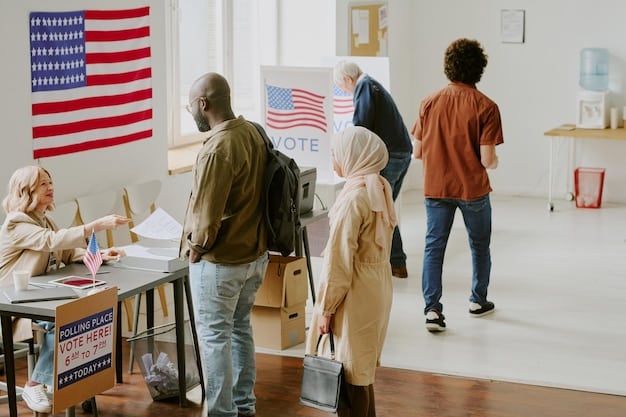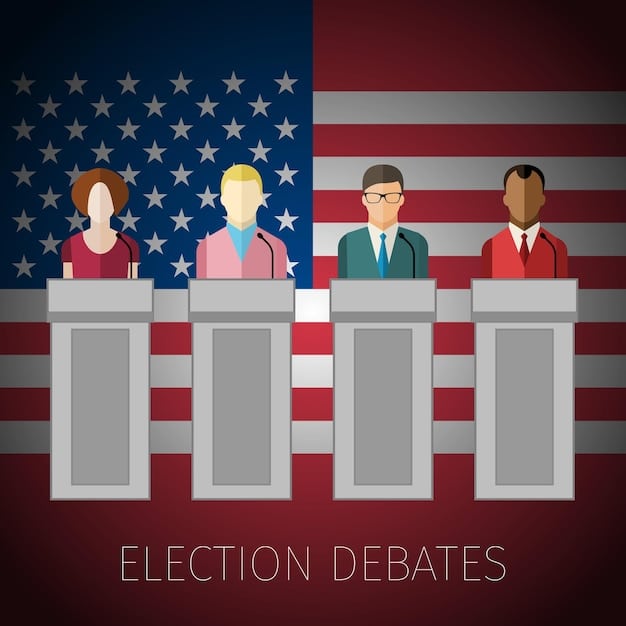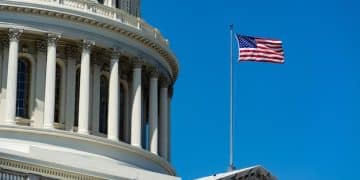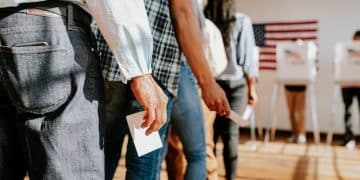What’s Next for Voting Rights After Supreme Court Rulings?

Following recent Supreme Court decisions regarding voting rights, the focus shifts to potential legislative actions, including updates to the Voting Rights Act, state-level reforms, and ongoing legal challenges aimed at protecting access to fair and equitable elections.
The landscape of voting rights in the United States is constantly evolving, especially in the wake of key Supreme Court rulings. Understanding **what’s next for voting rights legislation after the Supreme Court’s recent rulings** requires a look at the current state of affairs, potential legislative paths, and the ongoing debates shaping the future of American democracy.
Understanding the Supreme Court’s Recent Decisions
Recent Supreme Court rulings have significantly reshaped the legal framework surrounding voting rights in the US. These decisions have implications for state and federal laws, influencing the accessibility and fairness of elections.
Key Supreme Court Cases
Several landmark cases have defined the Court’s stance on voting rights. Understanding these cases is crucial for grasping the current legal environment.
- Shelby County v. Holder (2013): This case struck down Section 5 of the Voting Rights Act, which required certain states with a history of discrimination to obtain federal preclearance before making changes to their voting laws.
- Brnovich v. Democratic National Committee (2021): The Court upheld Arizona’s restrictions on out-of-precinct voting and ballot collection, making it harder to challenge voting rules under Section 2 of the Voting Rights Act.
- Milligan v. Alabama (2023): The Supreme Court upheld a lower court ruling that Alabama’s congressional map likely violated the Voting Rights Act by diluting the voting power of Black residents.
Each of these decisions has had a profound impact, either expanding or contracting protections for voting rights across the country.
Implications of the Rulings
The consequences of these rulings extend beyond the specific cases themselves, influencing how states can regulate elections and how legal challenges can be brought against them.
The Shelby County decision, for instance, led to a wave of new voting restrictions in states previously subject to preclearance. Similarly, the Brnovich decision has made it more difficult to challenge voting rules that may disproportionately affect minority voters. These rulings have motivated state legislatures to consider legislation aiming to restore voting protections.

In conclusion, the Supreme Court’s recent decisions have created a complex and evolving legal landscape for voting rights, highlighting the need for legislative action and continued legal advocacy.
Federal Legislative Efforts: The John Lewis Voting Rights Advancement Act
In response to Supreme Court decisions, particularly Shelby County v. Holder, federal lawmakers have introduced legislation aimed at restoring and strengthening voting rights protections at the national level.
Overview of the Act
The John Lewis Voting Rights Advancement Act is a key piece of legislation designed to address the issues raised by the Supreme Court’s rulings and to ensure equal access to the ballot box for all Americans.
Key Provisions
The Act includes several important provisions aimed at preventing voting discrimination and safeguarding the rights of voters.
- Restoring Preclearance: The Act seeks to reinstate a federal preclearance process, similar to that in Section 5 of the Voting Rights Act, but updated to reflect current voting rights challenges.
- Targeting Modern Forms of Discrimination: The Act identifies specific voting practices that could require federal review, such as changes to voter ID laws, polling place locations, and registration processes.
- Promoting Voter Access: The Act encourages states to adopt practices that promote voter access, such as automatic voter registration and online voter registration.
Challenges and Prospects
Despite its goals, the John Lewis Voting Rights Advancement Act faces significant challenges in Congress, including partisan divisions and disagreements over the scope of federal intervention in state election matters.
Given the current political climate, it is unclear whether the Act will be able to garner enough support to pass both houses of Congress and be signed into law. The Act has faced consistent opposition, hindering its progress.

In summary, the John Lewis Voting Rights Advancement Act represents a significant effort to address the challenges to voting rights in the US, but its future remains uncertain due to political obstacles.
State-Level Reforms and Challenges
While federal legislation is essential, many voting rights battles are fought at the state level. State legislatures are actively considering and implementing reforms aimed at protecting and expanding voter access, but also face challenges from restrictive voting measures.
Expanding Access to Voting
Many states have taken steps to make voting more accessible, including implementing automatic voter registration, expanding early voting options, and allowing same-day voter registration.
Key State Reforms
Several states have enacted laws to modernize and improve their election systems.
- Automatic Voter Registration (AVR): States like Oregon and California have implemented AVR systems, automatically registering eligible citizens when they interact with government agencies.
- Early Voting: States such as Georgia and North Carolina have expanded early voting periods, allowing voters to cast their ballots in person before Election Day.
- Same-Day Voter Registration: States like Maine and Wisconsin allow voters to register and vote on the same day, increasing participation and reducing registration barriers.
Restrictive Voting Measures
In contrast to efforts to expand access, other states have enacted laws that restrict voting, such as stricter voter ID requirements, limits on early voting, and cutbacks to polling places, particularly in minority neighborhoods.
These measures have sparked controversy and legal challenges, with critics arguing that they disproportionately affect minority voters and undermine democratic participation. Such laws can lead to reduced turnout and create barriers to voting, especially for marginalized communities.
In conclusion, the state-level landscape of voting rights is marked by both progress and challenges, with ongoing debates over how to balance voter access with election security.
Ongoing Legal Challenges and Litigation
Legal challenges and litigation play a crucial role in the fight for voting rights, as advocacy groups and civil rights organizations bring lawsuits to challenge restrictive voting laws and protect the rights of voters.
Key Areas of Litigation
Current legal challenges focus on several key areas, including voter ID laws, redistricting, and access to polling places.
Voter ID laws have been challenged in multiple states, with plaintiffs arguing that they disproportionately affect minority voters and impose undue burdens on the right to vote. Redistricting, or the drawing of electoral district boundaries, has also been a major area of litigation, with lawsuits alleging that gerrymandered districts dilute the voting power of certain communities.
Impact of Litigation
Legal challenges can have a significant impact on voting rights, as courts may strike down discriminatory laws, order states to redraw electoral districts, or require them to provide additional resources to ensure equal access to the ballot box.
Future Litigation Trends
Looking ahead, future litigation is likely to focus on emerging issues such as online voter registration, cybersecurity threats to election systems, and the impact of artificial intelligence on voter behavior.
As technology continues to transform the way elections are conducted, legal challenges will play an increasingly important role in safeguarding the integrity and fairness of the democratic process.
In summary, ongoing legal challenges and litigation are essential tools for protecting voting rights and holding states accountable for implementing fair and equitable election laws.
The Role of Civil Society Organizations
Civil society organizations, including advocacy groups, civil rights organizations, and grassroots movements, play a critical role in advancing voting rights and promoting democratic participation.
Advocacy and Education
These organizations engage in a range of activities, including voter registration drives, educational campaigns, and legislative advocacy, to raise awareness about voting rights issues and mobilize citizens to participate in the democratic process.
Community Mobilization
Civil society organizations also work to empower marginalized communities and ensure that their voices are heard in the political process, by organizing community meetings, town halls, and protests to advocate for policy changes and hold elected officials accountable.
These efforts have led to increased voter turnout and greater representation for underrepresented groups in government.
By empowering citizens to participate in the democratic process, civil society organizations contribute to creating a more inclusive and representative democracy.
Collaborative Efforts
Many civil society organizations work together in coalitions and partnerships to amplify their impact and achieve common goals. These collaborative efforts can be particularly effective in addressing complex issues such as voting rights, which require a multi-faceted approach.
In conclusion, civil society organizations are vital to advancing voting rights and promoting democratic participation, by empowering citizens, advocating for policy changes, and holding elected officials accountable.
The Future of Voting Rights Legislation
Looking ahead, the future of voting rights legislation in the United States is uncertain, with ongoing debates over how to balance voter access with election security and how to address the challenges posed by restrictive voting laws.
Potential Legislative Paths
Several potential legislative paths could shape the future of voting rights, including updates to the Voting Rights Act, reforms to campaign finance laws, and measures to protect election integrity.
Updates to the Voting Rights Act could strengthen federal oversight of state election laws and provide additional protections for minority voters. Reforms to campaign finance laws could reduce the influence of money in politics and level the playing field for candidates from all backgrounds. Measures to protect election integrity could include strengthening cybersecurity protections for election systems and combating disinformation campaigns aimed at suppressing voter turnout.
Challenges and Opportunities
The political landscape presents both challenges and opportunities for advancing voting rights in the years ahead. Partisan divisions and disagreements over the role of the federal government in state elections could make it difficult to pass comprehensive voting rights legislation. However, growing public awareness of voting rights issues and increasing mobilization by civil society organizations could create new opportunities for progress.
By working together to overcome these challenges, we can build a more inclusive and representative democracy where every citizen has the opportunity to participate in the political process.
In conclusion, the future of voting rights legislation in the United States depends on our collective commitment to protecting and expanding the right to vote for all citizens.
| Key Point | Brief Description |
|---|---|
| ⚖️ Supreme Court Rulings | Recent decisions have reshaped the legal framework of voting rights. |
| 🏛️ John Lewis Act | Aims to restore and strengthen national voting rights protections. |
| 🗳️ State Reforms | States are expanding access while others impose restrictions. |
| 🧑⚖️ Legal Challenges | Litigation is key to challenging restrictive laws and protecting voters. |
Frequently Asked Questions
▼
Shelby County v. Holder weakened the Voting Rights Act by eliminating the preclearance requirement for certain states, leading to new voting restrictions in areas with a history of discrimination.
▼
The Act seeks to restore key provisions of the Voting Rights Act, including updating the preclearance process and addressing contemporary forms of voter discrimination across the United States.
▼
Examples include automatic voter registration, expanded early voting periods, same-day voter registration, and online voter registration systems deployed in many states to increase voter participation.
▼
Current legal challenges often focus on voter identification laws, redistricting practices, and accessibility to polling places, particularly in minority and marginalized communities.
▼
They contribute by conducting voter registration drives, educating citizens about voting rights, advocating for policy changes, and mobilizing communities to participate in the democratic process.
Conclusion
The future of voting rights in the US hinges on legislative action, legal advocacy, and civic engagement. Understanding the implications of recent Supreme Court rulings and supporting efforts to expand voter access are crucial for upholding the principles of democracy and ensuring fair elections.





